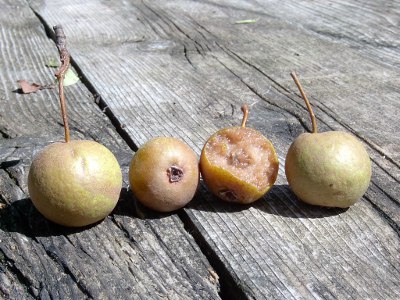︎︎︎ PERA SOMENTINA

La pianta madre è stata ritrovata nelle vicinanze di Pieve S. Stefano (AR). Veniva coltivata in queste zone di alta collina, in piante singole. Non se ne conosce l’origine, anche se viene spesso nominata dai testi antichi. La pianta è mediamente vigorosa, molto rustica, a portamento assurgente; è produttiva e fiorisce tardivamente.
Il frutto è piccolo e piriforme (gr. 80-100), con il peduncolo lungo e medio. La cavità calicina è piccola e mediamente profonda. La buccia è fine, di colore giallo con lievi rugginosità diffuse. Le lenticelle sono poche ma evidenti e rugginose. La polpa è bianca, succosa, molto zuccherina, non granulosa. Di eccellente sapore. Viene raccolta alla fine dell’estate, a fine agosto- inizio settembre, da consumo fresco e da conserve.
Viene nominata già dal Colummella ed altri eruditi romani come Sementina per l’epoca di maturazione, che coincideva con la semina. Nel ‘500 è citata da Mattioli e nel 1644 Tamara nota che è l’unica varietà ad aver mantenuto l’antico nome; nel ‘700 è ancora descritta nei manuali, tra le migliori pere da coltivare.
The mother plant was recovered in the areas around Pieve Santo Stefano (Arezzo). It was cultivated in these high hills areas, in isolated specimens. The origin is unknown even though it is often mentioned in old texts. The plant is on moderately vigorous, very rugged and with compressed habit; it is productive and blooms late. The fruit is small and pear-shaped. The stem is long and medium thick. The calyx is small and moderately deep. The skin is thin, yellow with widespread, light russeting. The lenticels are marked and russeted. The flesh is white, juicy, very sugary and non granular. It has an excellent flavor. It is harvested at the end of the summer, from the end of August to the beginning of September. It is suited for fresh consumption and for jams. It is mentioned by Columella and other Roman erudites as Sementina (seme = seed) for its maturation period coinciding with sowing time. In the 1500’s is quoted by Mattioli and in 1644 Tamara observes that it is the only variety to have kept its ancient name; in the 1700’s is still described in the manuals as being amongst the best cultivated pears.